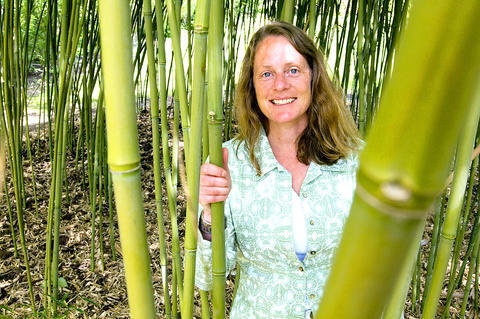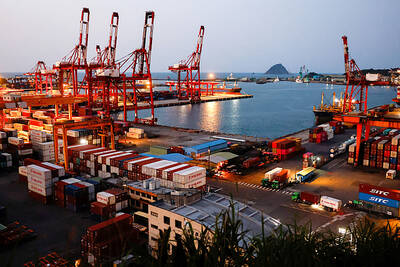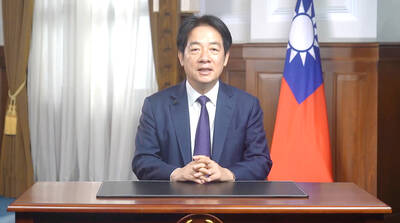Bamboo is a versatile, ancient plant that shows up in creation myths as well as in pots on Manhattan terraces. It comes in clumping varieties that behave themselves and running "timber" types that spread by rhizomes -- great for a grove, but not so good when they are planted as a property screen that escapes into a neighbor's yard.
But it's that very vigor that has environmentalists hailing bamboo as the new "it" plant for saving the earth.
Bamboo is a workhorse at sequestering carbon dioxide and pumping out oxygen. It is a tough plant that manufactures its own antibacterial compounds and can thrive without pesticides. And its porous fibers make a cloth that breathes and is as soft as silk. In fact, there is such a stampede of fabric designers to China and Japan, where it is farmed and processed -- no such industry exists in the US -- that in its May issue, National Geographic predicted that "this upstart fabric may someday compete with King Cotton."

PHOTO: NY TIMES NEWS SERVICE
Yet as the world clamors for more, bamboo is in short supply. A plant that generally flowers only every 60 to 120 years and then dies is hard to propagate from seed. And growing it by dividing existing plants is notoriously difficult.
So when Jackie Heinricher and Randy Burr figured out how to make bamboo in test tubes -- selling their first 2,000 plants in 2004 to local garden centers in the Skagit Valley in Washington -- they made waves in the world of horticulture.
"It's funny, because bamboo has this reputation for taking over the universe, and yet it's the hardest plant to produce," Heinricher, a biologist, said one afternoon in early June at the production center for her company, Boo-Shoot Gardens, here in Mount Vernon, a town about two hours north of Seattle.
Heinricher, who grew up with bamboo -- her father tended golden bamboos all around their house in Olympia, Washington -- first tried to propagate the plant in the late 1990s in a little greenhouse at her home in nearby Anacortes, where she lives with her husband, Guy Thornburgh, a marine biologist, and where she founded Boo-Shoot Gardens in 1998.
"I got interested in noninvasive bamboos early on, knowing that they were very beautiful, but impossible to make," Heinricher said. She quickly realized just how impossible, as she tried to divide some of her own rare specimens and watched many die.
So she persuaded Burr, an owner of nearby B&B Laboratories, to help her. Burr and his company had been in business for almost 30 years, with a 1,300m2 tissue culture lab and 3,700m2 of greenhouses. B&B had pumped out plants as varied as rhododendrons and cauliflower, and had figured out how to tissue-culture the Boston fern in 1973, for a nursery in Oxnard, California, and thousands of other plants.
"But bamboo was the hardest," Burr said, looking back over eight years of trying seemingly endless combinations of variables to trigger bamboo to regenerate in a test tube.
When I asked what finally worked, Burr stared back deadpan and said: "We'd have to shoot you."
Bamboo fibers are a renewable resource for fabric, food and paper. And experimental plantings in Alabama financed by the Agriculture Department between 1933 and 1965 showed bamboo's promise for paper and other wood products -- bamboo produced 13 tonnes of wood an acre, as against seven for loblolly pine, a major source of timber in the US.
Planted in large groves, bamboo can store "four times the carbon dioxide of a stand of trees of similar size," Heinricher said, citing a study by Jules Janssen of the Technical University Eindhoven in the Netherlands, in 2000.
"And it releases 35 percent more oxygen," she said.
Many of these plants can now be produced on a vast scale, which is revolutionary for the garden industry. Countries like Belgium have explored the tissue-culturing of bamboo, but Boo-Shoots appears to be taking the lead.
In the old days, bamboo had to be divided and grown to marketable size in a cycle lasting three to five years. Now Monrovia and other growers can buy trays full of young plants from Boo-Shoots, which are potted up and sold as a finished product to other wholesalers and retail nurseries across the country.
Developing tissue culture is a time-consuming process, Burr explained, in which a tiny cutting is sterilized in bleach, then put into a soup, or agar, of inorganic salts, plant sugars, hormones, vitamins and "all the building-block components that encourage tissue to generate and shoot new growth." Getting that formula right can take years.
And the rooting stage is tricky, too. "We'd put out 10,000 plants and lose 10,000," Heinricher said.

US President Donald Trump yesterday announced sweeping "reciprocal tariffs" on US trading partners, including a 32 percent tax on goods from Taiwan that is set to take effect on Wednesday. At a Rose Garden event, Trump declared a 10 percent baseline tax on imports from all countries, with the White House saying it would take effect on Saturday. Countries with larger trade surpluses with the US would face higher duties beginning on Wednesday, including Taiwan (32 percent), China (34 percent), Japan (24 percent), South Korea (25 percent), Vietnam (46 percent) and Thailand (36 percent). Canada and Mexico, the two largest US trading

China's military today said it began joint army, navy and rocket force exercises around Taiwan to "serve as a stern warning and powerful deterrent against Taiwanese independence," calling President William Lai (賴清德) a "parasite." The exercises come after Lai called Beijing a "foreign hostile force" last month. More than 10 Chinese military ships approached close to Taiwan's 24 nautical mile (44.4km) contiguous zone this morning and Taiwan sent its own warships to respond, two senior Taiwanese officials said. Taiwan has not yet detected any live fire by the Chinese military so far, one of the officials said. The drills took place after US Secretary

CHIP EXCEPTION: An official said that an exception for Taiwanese semiconductors would have a limited effect, as most are packaged in third nations before being sold The Executive Yuan yesterday decried US President Donald Trump’s 32 percent tariff on Taiwanese goods announced hours earlier as “unfair,” saying it would lodge a representation with Washington. The Cabinet in a statement described the pledged US tariffs, expected to take effect on Wednesday next week, as “deeply unreasonable” and “highly regrettable.” Cabinet spokeswoman Michelle Lee (李慧芝) said that the government would “lodge a solemn representation” with the US Trade Representative and continue negotiating with Washington to “ensure the interests of our nation and industries.” Trump at a news conference in Washington on Wednesday announced a 10 percent baseline tariff on most goods

ACTION PLAN: Taiwan would expand procurement from the US and encourage more companies to invest in the US to deepen bilateral cooperation, Lai said The government would not impose reciprocal tariffs in retaliation against US levies, President William Lai (賴清德) said yesterday, as he announced five strategies to address the issue, including pledging to increase Taiwanese companies’ investments in the US. Lai has in the past few days met with administrative and national security officials, as well as representatives from various industries, to explore countermeasures after US President Donald Trump on Wednesday last week announced a 32 percent duty on Taiwanese imports. In a video released yesterday evening, Lai said that Taiwan would not retaliate against the US with higher tariffs and Taiwanese companies’ commitments to